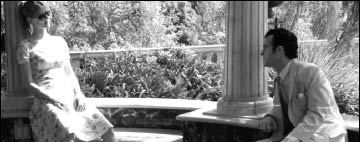A Woman In Trouble: INLAND EMPIRE
by M. Faust

Early in David Lynch’s INLAND EMPIRE (he prefers the title be capitalized, and if we’ve indulged him so far, why stop now?), two men speak in an ornate room in a house in Lodz, Poland. “I am looking for an opening,” says one. “Do you understand?”
Of course we understand—we’re all looking for an opening. It’s our nature to try to make sense out of the senseless, to interpret our elusive dreams and to plot a path on the random course of life. And if ever a film beggared that need, this is it.
It’s no secret that Lynch has never got on terribly well with Hollywood. Even at his peak of public awareness, when Blue Velvet and Twin Peaks made him a household name, he was only able to get feature films funded with foreign investment.
So it was all but inevitable that Lynch, like other creatively frustrated filmmakers, would turn to digital video. Working with a consumer-grade camera and no fixed script, just scenes he wrote as he went along, Lynch has made a film with complete creative control for the first time since Eraserhead.
And that’s all that can and perhaps should be said about INLAND EMPIRE, that it is an undiluted dose of Lynch. By which you should not expect an unrelenting dose of sadism and grotesquerie, a la the more difficult moments of Blue Velvet, Wild at Heart and Eraserhead: Advance warnings about the violence in this movie proved to be ridiculously exaggerated. (Bear in mind that one of the most purely Lynchean films, at least of a certain part of his psyche, was the G-rated The Straight Story.)
Pressed for a description, Lynch will tell you only that INLAND EMPIRE is about “A woman in trouble.” I won’t get caught in the trap of offering my own interpretation of how the various parts of the film can be tied together into a plot. If you need some kind of an opening, try this: An actress (Laura Dern) is visited by a gypsy woman (Twin Peaks’ Grace Zabriskie) who infects her with madness. She is almost literally cast down the rabbithole, like Alice entering Wonderland. The difference being that Alice knew she was on a trip.
After a disorienting opening, much of the first hour of the film seems relatively conventional, to the point where you feel that if you can just keep your head above water everything will become clear in the end. Put that thought right out of your mind. If you go through all three hours of INLAND EMPIRE trying to wrestle it into logical submission, you will lose.
This warning applies even to the diehard Lynch mob, who will pick up every repeated trope and reference to other works in the Lynch canon. There are plenty of them, primarily the theme of fractured identity. But unlike Mulholland Drive, this isn’t a puzzle waiting to be assembled. If that sounds daunting to you, well, consider yourself warned.
If you want my opinion, I think it is about movies and the process of watching them. I find it interesting that, for as many films as I’ve seen in my life, and for as much as I know about the process of making them, when I’m watching one I never see it as the artificial construct I know it to be. No matter how ridiculously conceived, badly acted or shoddily produced, it still has a life. It takes me into a world of its own—even if it’s one that doesn’t make any sense. That’s the great power of movies, to draw us in like no other art form. The figures we watch in Lynch’s film are to some degree involved in making movies, whether they know it or not, and they fall into that gap between the world we know exists and the world we allow to exist in our imaginations when we watch a film. They are people who don’t know they are actors in a movie; they are actors who have lost track of what is their life and what is their performance; they are characters who don’t know that they have no reality.
(They can even be rabbits, though there’s very little of that, which you may be relieved to know if you’ve ever tried to watch more than five minutes of the “Rabbits” shorts Lynch made for his Internet site a few years ago, snippets of which are included here.)
Am I giving you much reason to go see this movie? Maybe not. INLAND EMPIRE generally lacks the qualities that have made Lynch a favorite of cheap thrillseekers: There’s none of the silly outrageousness of Wild at Heart. Visually the use of digital video doesn’t allow for the sumptuous colors that made many of Lynch’s features such eye candy. I wouldn’t call watching it a painful experience, but neither would I call it pleasurable.
But it’s undeniably involving. At three hours, it has more than enough time to seep into your subconscious and take root. Most of the scenes are intriguing in and of themselves, if you can set aside the impulse to relate them to what has come before. And Lynch’s usual obsessive sound design, in which low, ominous hums and bursts of unsettling noise occasionally burst out of long stretches of silence, keeps a hold on you even if you doze off for a minute or two.
INLAND EMPIRE will be showing for one week only at the Amherst Theater. There will be late-night screenings starting at 11:30pm on Friday and Saturday night, and I can’t imagine a better way to see it.
|
Issue Navigation> Issue Index > v6n17: Why Not Vote for a Change? (4/26/07) > Film Reviews > A Woman In Trouble: INLAND EMPIRE This Week's Issue • Artvoice Daily • Artvoice TV • Events Calendar • Classifieds |









 Current Issue
Current Issue